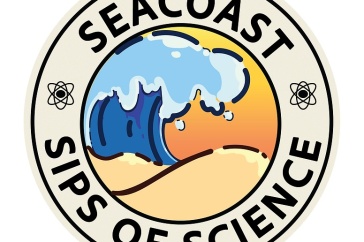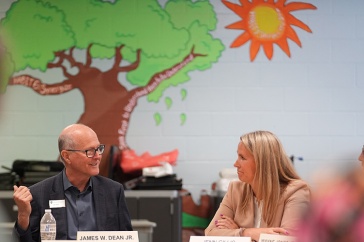
|
|
Students from Oyster River Middle School conduct water quality testing at several points on campus and then analyzed their samples. The event was part of the NH EPSCoR Ecosystems and Society project.
On an overcast April morning, a dozen fifth-graders from nearby Oyster River Middle School follow College Brook downstream from Gregg Hall to the Memorial Union Building, clambering up and down the steep bank to take measurements related to water quality. At different points, they spot a waterlogged mop, a sunken dead frog, floating beer cans and two ducks swimming.
Behind Kingsbury Hall, they test a small, unnamed stream that runs into the brook: One student crouches at the water’s edge and dips a conductivity meter into the current. The instrument measures electrical conductance, which relates to the amount of salt in the water, both naturally and from pollution, and can be an indicator of other contaminants. The reading – 2,653 micro-siemans per centimeter – is several times higher here than anywhere else.
“Wow,” says Kevin Gardner, a professor of civil engineering at UNH who’s leading the group. “That’s totally different. It could be that some kind of pollution source is entering the stream. Where do you think it’s coming from?”
His question has real-life implications. The fifth-graders’ investigation will help the town of Durham identify sources of pollution that enter College Brook and flow into Oyster River — the drinking water supply for UNH and Durham — and ultimately into Great Bay, New Hampshire’s most important estuary. Specifically, their data will enable Gardner’s colleague Wil Wollheim, an assistant professor of biogeochemistry, to develop a map of salinity along College Brook. As these students test the segment of College Brook that meanders through campus, another team follows the brook into the College Woods to see if salinity is higher or lower there. A third group conducts experiments with Research Scientist (and UNH alum) Scott Greenwood ’05, ’08G, trying to determine which materials (such as fine sand, coarse gravel, bark mulch, rock salt and packing peanuts) are most effective at filtering dirty water. Also providing instruction and assistance are half a dozen UNH undergraduate and graduate students.
This field and lab experience, involving nearly 50 fifth-graders, gave the students a chance to learn about the pollutants affecting their own watershed, including their school’s namesake, the Oyster River. The half-day event was supported by NH EPSCoR’s Ecosystems and Society project, a federally funded, statewide initiative that studies interactions among climate, land use, ecosystem function and people. The project aims to better understand the impact of human activity on New Hampshire’s water resources, while also providing authentic research experiences for the state’s young people, especially those from underrepresented groups. A major goal is to train K-12 teachers to incorporate inquiry-based learning into their curriculums.
“I don’t know that we do a great job of teaching innovation and creativity, particularly in the sciences, but those skills are a crucial part of a satisfying career and of being economically competitive in a global market,” says Gardner, associate director of NH EPSCoR, which last year received a $20 million National Science Foundation grant to carry out the five-year Ecosystems and Society project. “Inquiry-based teaching encourages creative and critical thinking. Plus, the kids love it.”
The Oyster River fifth-graders were no exception – even though it was the Friday before their weeklong April break. “I learned where we get our water from, which is really interesting,” says Jane Schwadron, who’s also interested in oceanography and marine biology. “And I learned how important it is to treat the water with good care, because when you look around there’s a lot of pollution.”
Mia Loureiro, who measured the conductivity of College Brook near the rear entrance to the Paul Creative Arts Center, says it was exciting to be involved in a real research project. “We were using the tools that scientists use, and I thought that was pretty cool.”
Sunny Sadana, a fifth-grade science and math teacher at Oyster River Middle School, says he reached out to a parent group that includes Gardner (the father of a fifth-grader) because he wanted his students to experience hands-on science in the field. “I think experiential education is way more powerful than anything you can get from a textbook, movie or website,” he says. “It makes the kids more invested in their learning because it’s meaningful to them.”
His students remained engaged when they returned to the classroom last week and began discussing their UNH fieldwork, applying what they had learned to their own behavior. For instance, one student said she wants to rely solely on public transportation because cars can leak oil, which enters the soil and may contaminate the water supply. “As an educator, I was proud that the kids could make those connections,” says Sadana, who earned his master of education degree from UNH in 2010. “And it all stemmed from what they observed when they were standing by College Brook.”
Their learning will continue: Sadana plans to examine a larger UNH data set with his students that reveals the changes in salinity at a single point in College Brook during a weeklong period. And next year, Sadana hopes that the students themselves will have a chance to collect water data over time. That would allow them to discuss how seasonal activities such as the salting of roads influence stream health. “I would love to be able to do this on my own with the kids,” he says.
Originally published by:
UNH Today
Written by Sonia Scherr ’13 MFA
-
Written By:
Staff writer | Communications and Public Affairs



















































